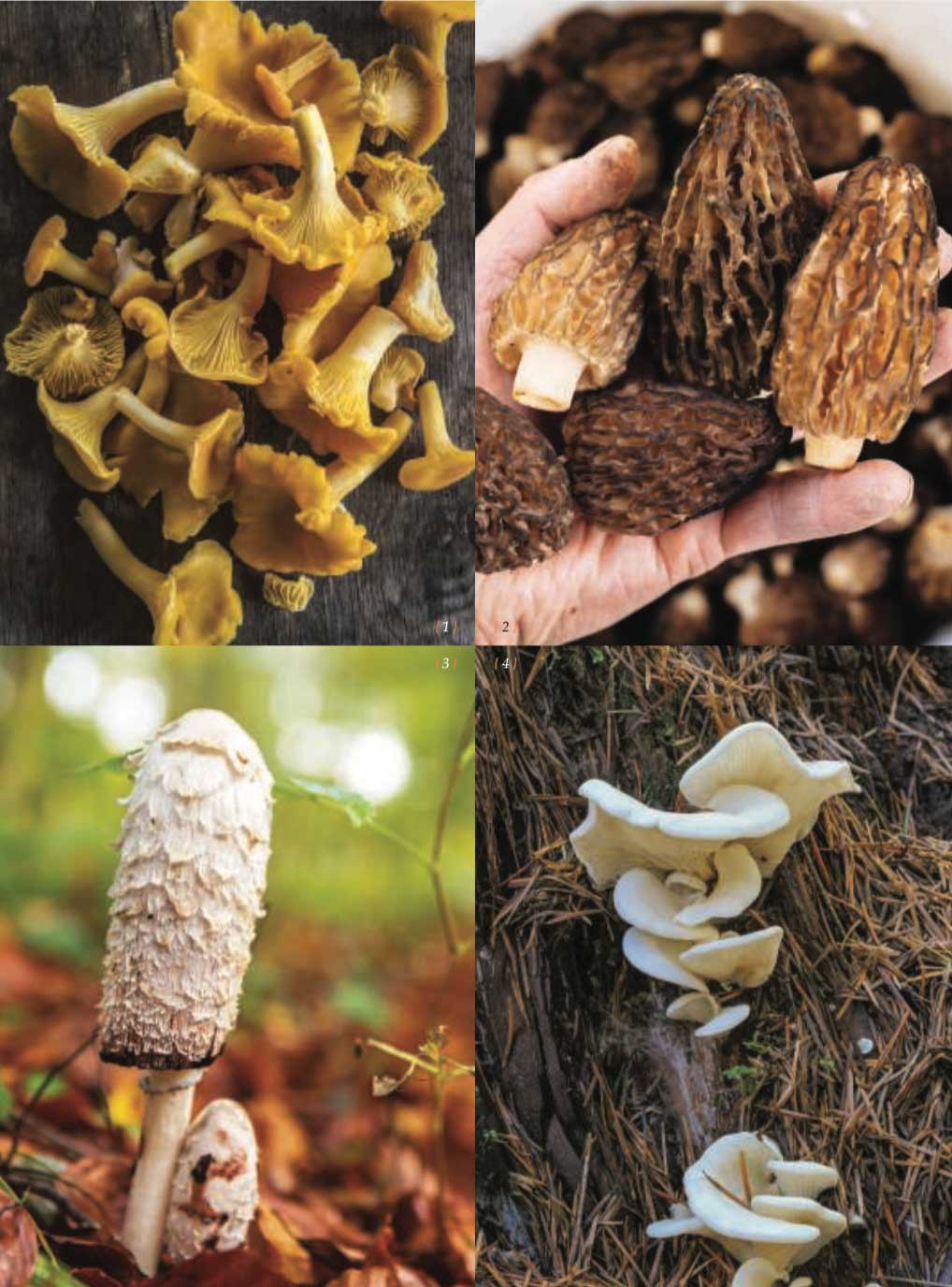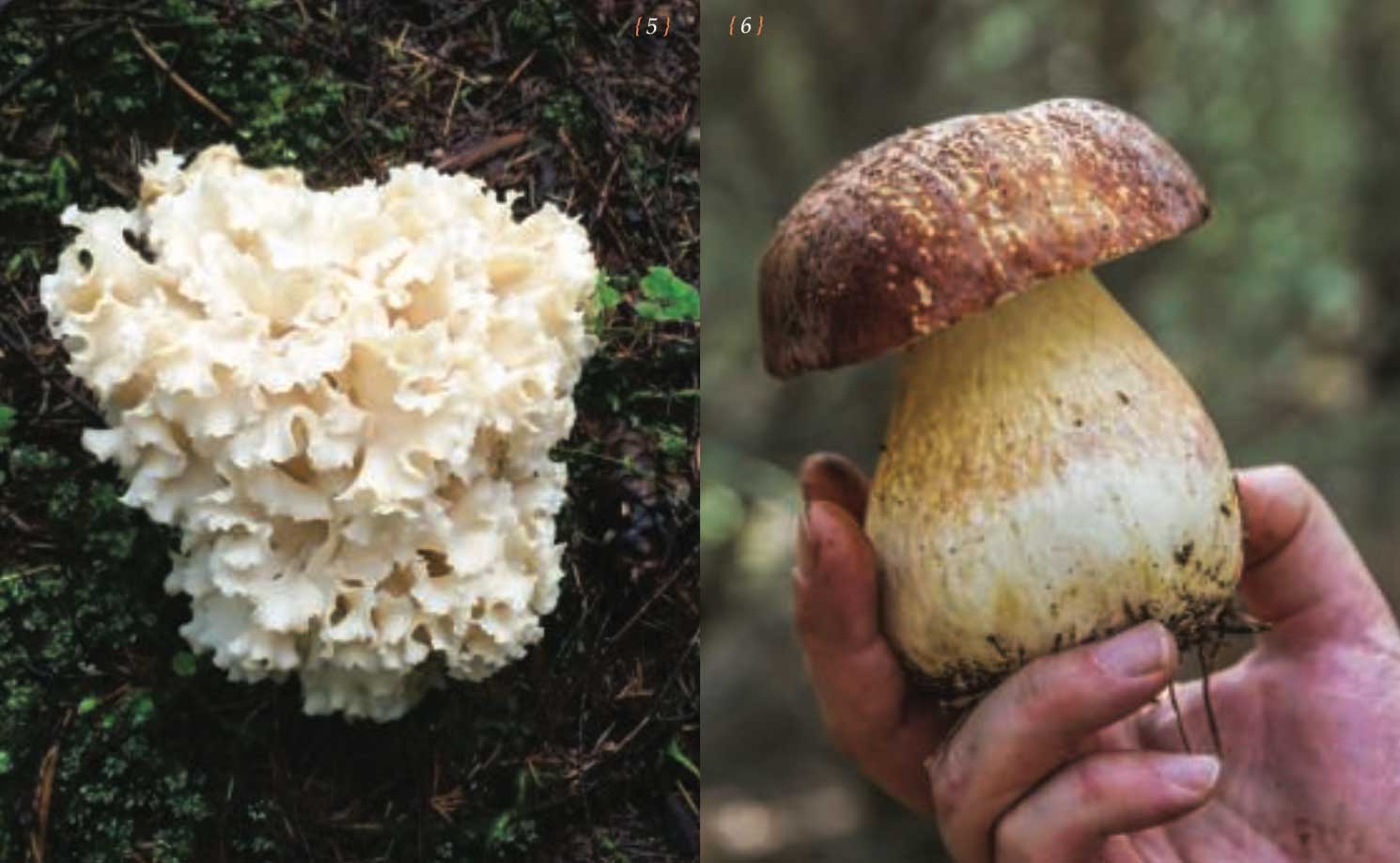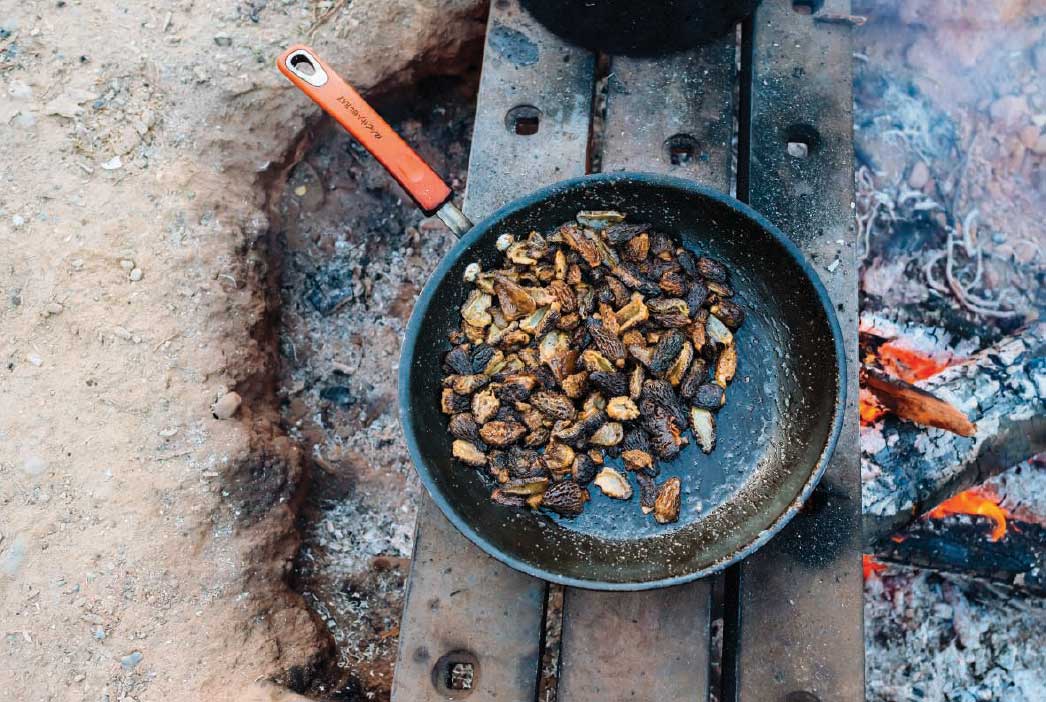I’m battling creepers, mini sinkholes and brambles as I wrestle through the bush—keeping one eye down on the wily vines threatening to trip me up and the other on the habitat ahead. This is cougar and bear country, after all. The late fall drizzle is fingering my collar, the firs are slapping me in the face and did I say I’m lost? I pull out my whistle and blast.
“Over here,” I hear my partner, David, holler, to my relief. “…And I’ve found some!” There is nothing as exciting as that first find of the year and I slosh awkwardly through the underbrush, eventually spotting him waiting, knife poised.
What could possibly be worth finding that would drive a spry but nevertheless senior couple into the rain and soggy bush when their age gives them every right to curl up by the ire with a good book, a hot toddy and no guilt?
Mushrooms, of course. Rabid foragers for decades, we have gradually expanded our repertoire and knowledge of one of nature’s most delectable gifts. While the dangers of mushrooming are widely known, and cannot be stressed enough, foragers who exercise care and caution can still enjoy a walk (and a taste) on the wild side. The following six-pack has been chosen based on the criteria of availability, taste, ease of identification and popularity.
You may wonder why the most commonly known mushroom, the field mushroom, has been left out. It’s because we feel it’s too easy to misidentify. (The destroying angel, for example, might look the same to a novice.)
Our Six Pack Of Fungi For First-Timers

Chanterelles {Photo 1}
(Both white and Pacific golden chanterelles.) This is our favourite fall forage. While the experts say they can be gathered year-round, we have only ever found them on the West Coast in fall, that damp time of year when the majority of mushrooms begin to cast shadows. In praise of chanterelles, their lovely golden heads make them easy to spot, they have a fruity (apricot) smell, a delicious taste, can grow to a good size without losing their texture or being invaded by insects and they’re abundant.
As master forager, chef and author Bill Jones, writes in his Deerholme Foraging Book: “The yellow chanterelle is probably the best mushroom with which to start your foraging career. It is fairly easy to identify, abundant and the mushrooms that look like it won’t kill you (always a bonus).”Look for them in lush, mossy spots in the forest under mature conifers, especially Douglas-fir. (Whenever you come across a grove of alders—abandon the hunt.)
Chanterelles can be identified by their colour, their forked gills which run down into the stalks and their wavy-edged cap as well as that distinctive fruity aroma. The closest look-a-like is the jack-o’-lantern, which may make you lose your lunch but won’t kill you, and reassuringly there are several significant differences between them. The jack-o’-lantern has no odour, its gills are not forked, its caps are rather circular, not wavy-edged and it tends to grow at the base of trees or stumps.
We often eat them fresh, but our favoured preservation method is to quickly sauté chanterelles in garlic and olive oil and season with salt and pepper be- fore freezing them in their juice in small batches. We find the taste is much better compared to freezing them uncooked or drying them.
Morels {Photo 2}
This is our favourite spring pick, generally found around Easter and a month afterward. Jones mentions four varieties, all of which are edible (black morel, common morel, burnsite morel, yellow morel). Considered the crème de la crème of mushrooms, morels are chewy, very tasty and irm. They can be found in a variety of habitats. Logged or burned areas are our preferred hunting grounds and we have hit mother lodes at campsites and especially in areas that have recently suffered forest fires. The challenge is in finding them; they’re remarkably good at blending into the surroundings. We can pass over the same small area as much as five times and still find ones we’ve missed. Also, un- like many mushrooms, morels don’t stay put year after year, so hunting out their hiding places is an annual activity.
Morels don’t have gills. Their distinctive honeycombed caps, which are often pointed, appear ridged and pitted inwards and the cap and the hollow stem are fused. Their closest look-a-likes are the false morels, which can be deadly, especially if eaten raw. However, there’s an easy way to avoid this fungus; cut lengthwise through the mushroom and the stem should be hollow. If it’s ibrous or chambered, drop it. If you’re still nervous, a second precaution is to check the colour. False morels are usually brownish red, colours not found on the edible morels.
This mushroom dries easily and retains its flavour so we preserve it by dehydrating. We slice the mushrooms lengthwise first because it is not uncommon for ear- wigs or sow bugs to have snugged into the hollow centre.
Shaggy Manes {Photo 3}
Found in both summer and fall, these were the mushrooms that hooked us on mushrooming so many years ago. If you want to start out with only one species, this is it. Shaggy manes are simple to identify, widespread and easy to find. While gourmet chefs might eschew this fragile fungi, we find the flavour delicate and tasty and because when cooked they emit a lot of juice, we consider them our go-to mushroom for soups, sauces, gravies and casseroles.
They grow in tight groups and appear quickly after rainfall. We’ll often discover clumps of them by the roadside but they can also appear in grassy and disturbed areas. Shaggy manes have a distinctive bullet-shaped, tall cap with brownish scales, white gills turning darker with age and a smooth white, fragile stem.
The little delicacies are amazingly quick to turn black (which has earned them the moniker of inky caps). Being highly perishable, they need to be dealt with quickly after harvesting; you can collect them first thing in the morning and then find a puddle of ink in late afternoon. So—choose young specimens and cook them fast. Many are the times we have had to pass up a good haul because we knew we couldn’t get home in time to deal with it.
Avoid mushrooms growing alone, as shaggy manes generally like company, and go for specimens more than four inches tall, as the look-a-likes don’t get any higher than that. Lincoff, the author of my mushroom bible, writes that no look-a- likes have cylindrical, white, shaggy scale caps or long fragile stems.
We quickly cook the mushrooms with seasoning—no need to add butter or oil as this is a very juicy mushroom and you’ll soon have a pan of liquid. Frying them up with a steak just doesn’t work, but storing the mushrooms in their juice and then freezing them works just fine.
Oyster Mushroom {Photo 4}
Fall is the only time we’ve ever found oysters, although many books herald them as a year-round wild harvest. They are, however, readily available commercially throughout the year. Their white or grey caps are a welcome sight on the trees, stumps or fallen logs where they usually preen in clumps.
We love their crisp texture and flavour and the fact that they often like to hang out in the same place year after year. They’re also widespread and often found in the same woods as our chanterelles.
Oyster mushrooms are a good bet for mushrooming newbies because of their abundance and their easy identification. The gills run all the way into the stem and unlike most mushrooms, are not separate from it. Their caps are smooth with white flesh. There are a number of look-a-likes but fortunately the sole poisonous one is found only in Japan and Australia.
The oyster mushroom dries well and can be frozen without losing much of its flavour. It also doesn’t reduce much and has less juice, so bring on the steaks!

Cauliflower Mushroom {Photo 5}
We’re always delighted when we discover one of these beauties on our fall forays. Bill Jones writes that they are usually found at the base of rotting Douglas-fir stumps and that is exactly where we find them, although it’s reported that any conifer will apparently do, as will oak trees. This gigantic fungus is rated highly with mushroom collectors because of its aroma and crispness. We love that cauliflowers are usually very large, and one mushroom can easily weigh three kilograms, thus enhancing a whole lot of dinners.
Like the oyster mushroom, it can often be found in the same spot annually. It’s also hard to miss or mistake, described as resembling a bouquet of egg noodles or a compact bunch of ribbons. There are no poisonous look-a-likes.
Jones recommends immersing the whole fungus in water and salt to dispense with the insects and it does make the whole cleaning job easier. For sure it’s a more difficult fungus to clean because of all its branches, but it’s worth it. It dries easily, keeps its shape when cooking and its crispness always reminds me of sliced almonds. Although it has a reputation of being tough, we haven’t noticed that. Our preferred method of preserving is to dry it. It reconstitutes very well.
Kingbolete {Photo 6}
Exciting as it is to discover any of these six-pack mushrooms, when we come across a king bolete (or porcini) we do a happy dance. This choice fall mushroom is almost impossible to cultivate commercially, which makes it even more exciting to come across it in the wild. It’s a meaty, firm and delicious fungus that lasts well in the fridge. It loves conifer woods and has saved my bacon several times when hiking in summer with a boring and rapidly depleting food supply because it’s also present in summer at high altitudes.
Another asset is that it cannot be mistaken for anything nasty in North America, with the exception of Satan’s bolete, which is bright red under the cap and down the stem. Many of the nasty species have gills, but the boletes have a sponge-like under- side that’s easily identifiable. That doesn’t mean they are all edible, of course, but the king has several distinguishing features: a very broad white to brown stem which is usually largest at the bottom and a medium to large cap that’s red to brown.
We scored one of these last year and ate it every night for 10 days. It’s a nutty, firm mushroom; the stem is especially tasty. There is a down side, however. The whole bolete family is a favourite of bugs and worms who really get into that spongy underside. To avoid most of them, pick younger specimens and check underneath. If there are no holes or just a few, it’s harvest time. Examine them length- wise before cooking, though, just to ensure there are no unwanted ingredients at dinner.
There’s no bad way to cook the king and if you are lucky enough to have a haul that requires some preservation, I recommend drying.
IN ADDITION TO getting you outside and active, wild mushrooms can be a wonderful addition to your larder. They’re nutritious, add a gourmet touch to all your meals, are fresh and organic, and they’re free. They can also enhance your popularity. (We always get a lot of dinner invitations in the fall.)
Mushroom hunting is a little like hunting for chocolate Easter eggs. It brings out the thrill of the chase, the fun of discovery and the pleasure of eating.
Have the rains come yet?
Mushrooming Tips
To cut or not to cut?
The jury seems to still be out on this. When collecting, we prefer to cut because it eliminates much of the dirt and disturbs the habitat less.
To dehydrate or not to dehydrate?
We’ve tried drying chanterelles (changes the taste) and freezing them (makes them soggy) and finally settled on a little pre-cooking before freezing. Other mushrooms like morels and cauliflowers dry beautifully.
To wash or not to wash?
Ugh—I know this goes against everything our mothers taught us, but it’s better to not wash mushrooms. They’re sponges. Use a pastry brush or damp cloth to brush off dirt and needles.
To whistle or not to whistle?
It’s so easy to get lost as you go further and further into the woods and get totally turned around. Be aware of your surroundings because it is amazing how normally cautious people can get totally confused after searching for those elusive morsels. So take that whistle and a compass too.
Mushroom Bytes
- While you don’t need a licence to gather mushrooms, examples abound of what happens when we take more from nature than what’s sustainable. Take just what you need and be respectful of the surroundings. We like to do our cleaning and cutting in situ, so the spores get back into the same area.
- Of the over 10,000 species of mush- rooms in the Pacific Northwest, it’s estimated that only about 50 species are edible. (Bill Jones, The Deerholme Foraging Book.)
- Be careful when trying mushrooms for the first time, no matter how certain you are that you have identified the species.
- Add some mushroom books to your library and have them with you.
- Take spore prints religiously, even if this means you have to wait a day before feasting.
- Use separate containers for each species of mushroom. That way, if you later find you’ve misidentified a species, you don’t have to throw the whole lot away. Be sure to carefully wash hands, containers and tools if you suspect you have handled any inedible or poisonous mushrooms.
- It’s tempting, but better not to mix alcohol with mushrooms as even choice mushrooms can negatively affect some people. (My mother had a bad reaction mixing wine with the coveted pine mush- room, for example.)
- Never eat any wild mushrooms raw.
- Take only a small amount the first time you taste a new mushroom and if the taste or smell is off—toss it.
- Avoid picking small mushrooms. They are much more difficult to identify. It’s also better for the environment to give fungi time to mature and fruit (dispense spores.)
- Gather in a basket or cloth bag so that the spores can disperse as you move. Avoid plastic. The mushrooms will also fare better if they are not crushed or crammed.
- Dispose of mushroom trimmings in a similar habitat to where you picked them.
- Do not take dogs or young children on your treks. Better safe than sorry.
Reference Books
There are many out there, but our favourites are:
All That the Rain Promises and More, by David Arora
The Complete Mushroom Hunter, by Gary Lincoff
The Deerholme Foraging Book, by Bill Jones
National Audubon Society Field Guide to North American Mushrooms
For more info: northernbushcraft.com


